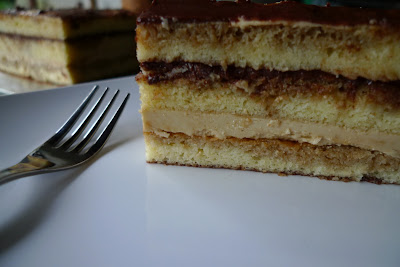Taken from Wikipedia: Financier is a term for a person who handles typically large sums of money. The term is French, and derives from finance or payment. The term financier has upscale and haughty connotations, and the stereotype portrayed by the term is typically of a wealthy and powerful person.
Pronounced as fee-nahng-syehr. These financiers fortunately don't cost a lot to bake. Unfortunately, these financiers don't make me rich. Here in Adelaide, they call them Friands and instead of the traditional gold bar shape, they are usually oval-ish. Taste wise, they're pretty similar, just that friands usually has some fillings on them.
So... What makes a financier a financier? The 2 key ingredients are almond meal and brown butter. Or as a french would say, beurre noisette. And if you would translate it literally back to English, it would mean hazelnut butter. Basically, it's just butter which has been cooked till it's melted and the milk solids starts to caramelise. You could add some milk powder while browning the butter to get a richer flavour.
Financiers are best eaten fresh out of the oven. If not, they can always be microwaved(10-30sec) to perk them up. They go well with a cup of tea or coffee and make a great afternoon snack.
Honey financiers by
Makes 12
Ingredients
1 cup whole blanched almonds
1/3 cup sugar
3 tablespoons flour
1/4 teaspoon salt
85g unsalted butter
1/3 cup honey
2 eggs
1/3 cup sugar
3 tablespoons flour
1/4 teaspoon salt
85g unsalted butter
1/3 cup honey
2 eggs
Instructions
Preheat the oven to 180°C
In a food processor, mix the sugar and almond until finely ground. Combine with the flour and salt in a mixing bowl and set aside.
Melt the butter in a small saucepan over gentle heat. Bring to a simmer and cook for 2 minutes, until lightly browned and nutty-smelling. Add the honey and stir to melt. Pour the butter mixture into the dry ingredients and whisk until combined. Add in the eggs and whisk well.
Melt the butter in a small saucepan over gentle heat. Bring to a simmer and cook for 2 minutes, until lightly browned and nutty-smelling. Add the honey and stir to melt. Pour the butter mixture into the dry ingredients and whisk until combined. Add in the eggs and whisk well.
Butter the moulds if they're not nonstick or otherwise blessed with magical powers, then pour the batter in each individual mould, filling it up just to the rim. If you like, you can add raspberries (a line of three for the regular-sized ones, like buttons on a clown outfit, or just one on top of mini ones), pushing them down in the batter slightly, or pistachios, or chocolate chips (these you shouldn't push down).
Bake for
10 to 18 minutes, depending on the size and shape of your molds. The financiers
should puff up a bit, get golden and slightly crusty on the edges, but they
will still feel soft to the touch. Let stand for a few minutes, before turning
them out on a rack to cool completely. The bottoms have a tendency to be a bit
sticky when still warm, so you may want to put them upside down on the rack, or
put them on a sheet of parchment paper.































